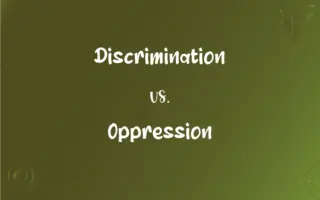Powdered Sugar vs. Confectioner’s Sugar: What's the Difference?
By Janet White || Published on January 27, 2024
Powdered sugar and confectioner's sugar are the same: finely ground sugar often mixed with a small amount of cornstarch to prevent clumping.

Key Differences
Powdered sugar, also known as confectioner's sugar, is granulated sugar that has been finely ground into a powdery consistency. This sugar is ideal for use in icings, frostings, and dusting over desserts due to its fine texture that easily dissolves.
Confectioner's sugar often contains a small amount of cornstarch (about 3% to 5%) to prevent clumping. This is true for powdered sugar as well, which is why it's preferred in recipes where a smooth texture is essential, like in glazes or creamy fillings.
The smoothness of powdered sugar, synonymous with confectioner's sugar, makes it a perfect choice for decoration on cakes and pastries. Its ability to blend seamlessly into mixtures without granules being visible is a shared characteristic in both.
Powdered sugar, or confectioner's sugar, can be made at home by grinding granulated sugar, though it's difficult to achieve the same fineness as commercially produced versions. This homemade version is used similarly in various confectionery and baking recipes.
Both powdered sugar and confectioner's sugar are available in different degrees of fineness, with 10X being the most common in the United States, indicating it has been ground ten times. This degree of fineness ensures a silky texture in frostings and icings.
ADVERTISEMENT
Comparison Chart
Composition
Finely ground granulated sugar, often with cornstarch
Same as powdered sugar
Texture
Fine, powdery consistency
Identical to powdered sugar
Use in Recipes
Ideal for icings, frostings, and dusting
Same uses as powdered sugar
Homemade Version
Can be made by grinding granulated sugar
Same method for confectioner's sugar
Fineness Varieties
Available in various degrees of fineness
Same varieties as powdered sugar
ADVERTISEMENT
Powdered Sugar and Confectioner's Sugar Definitions
Powdered Sugar
Powdered sugar can be made at home by grinding granulated sugar.
Out of confectioner's sugar, she made her own powdered sugar in a blender.
Confectioner's Sugar
Confectioner's sugar is powdered sugar, fine in texture and used in baking.
The lemon pound cake recipe called for confectioner's sugar for the icing.
Powdered Sugar
Powdered sugar dissolves easily, making it perfect for smooth frostings.
For the buttercream icing, he used powdered sugar to ensure a silky texture.
Confectioner's Sugar
Confectioner's sugar is perfect for dusting on desserts for a sweet, elegant finish.
A sprinkle of confectioner's sugar made the fruit tart visually appealing.
Powdered Sugar
Powdered sugar is finely ground granulated sugar, often mixed with cornstarch.
She sifted powdered sugar over the freshly baked brownies for a sweet finish.
Confectioner's Sugar
Confectioner's sugar blends seamlessly into mixtures, ideal for frostings.
He used confectioner's sugar to make the chocolate frosting smooth.
Powdered Sugar
Powdered sugar is used for dusting desserts for a decorative and sweet touch.
The French toast was topped with a light dusting of powdered sugar.
Confectioner's Sugar
Confectioner's sugar is often used for sweetening whipped cream.
To sweeten the whipped cream, she added a tablespoon of confectioner's sugar.
Powdered Sugar
Powdered sugar is a key ingredient in homemade fondants and glazes.
She mixed powdered sugar with milk to create a simple glaze for the cake.
Confectioner's Sugar
Confectioner's sugar contains a small percentage of cornstarch to prevent clumping.
The confectioner's sugar in the pantry remained lump-free thanks to the cornstarch.
FAQs
Can I use powdered sugar and confectioner’s sugar interchangeably?
Yes, they are the same and can be used interchangeably in recipes.
What is confectioner’s sugar?
Confectioner's sugar is the same as powdered sugar, used in baking and confectionery.
Why does powdered sugar contain cornstarch?
Cornstarch is added to prevent clumping and ensure a smooth texture.
Is there a difference in fineness between powdered sugar and confectioner’s sugar?
No, they are typically available in the same fineness grades, like 10X.
What is powdered sugar?
Powdered sugar is granulated sugar that's been finely ground, often with a bit of cornstarch.
Is powdered sugar healthier than granulated sugar?
No, it's just finer in texture but nutritionally similar to granulated sugar.
What are common uses of confectioner’s sugar?
Common uses include icings, frostings, and dusting over desserts.
Is powdered sugar vegan?
Generally, yes, but it's best to check the brand for any non-vegan additives.
Is confectioner’s sugar suitable for diabetics?
Like any sugar, it should be consumed cautiously by diabetics.
Can I make powdered sugar at home?
Yes, by grinding granulated sugar, though it may not be as fine as store-bought.
How should I store powdered sugar?
Store it in a cool, dry place in an airtight container.
Can confectioner’s sugar go bad?
It doesn't spoil, but it can absorb odors and moisture if not stored properly.
Can I use powdered sugar in place of granulated sugar?
Not always, as its finer texture can affect the recipe's outcome.
Is confectioner’s sugar the same as icing sugar?
Yes, in many places, confectioner's sugar is also known as icing sugar.
Does confectioner’s sugar have gluten?
It's usually gluten-free, but cross-contamination can occur, so check the label.
Are there any sugar-free alternatives to confectioner’s sugar?
Yes, sugar-free substitutes are available, often made with artificial sweeteners.
Can I use confectioner’s sugar in beverages?
Yes, its fine texture dissolves easily in beverages.
How do I prevent clumps in powdered sugar?
Sift it before use and store it properly to prevent clumping.
How do I measure powdered sugar correctly?
It should be spooned into a measuring cup and leveled off, not packed.
Can I use powdered sugar for caramelizing?
No, its fine texture and cornstarch content make it unsuitable for caramelizing.
About Author
Written by
Janet WhiteJanet White has been an esteemed writer and blogger for Difference Wiki. Holding a Master's degree in Science and Medical Journalism from the prestigious Boston University, she has consistently demonstrated her expertise and passion for her field. When she's not immersed in her work, Janet relishes her time exercising, delving into a good book, and cherishing moments with friends and family.


































































